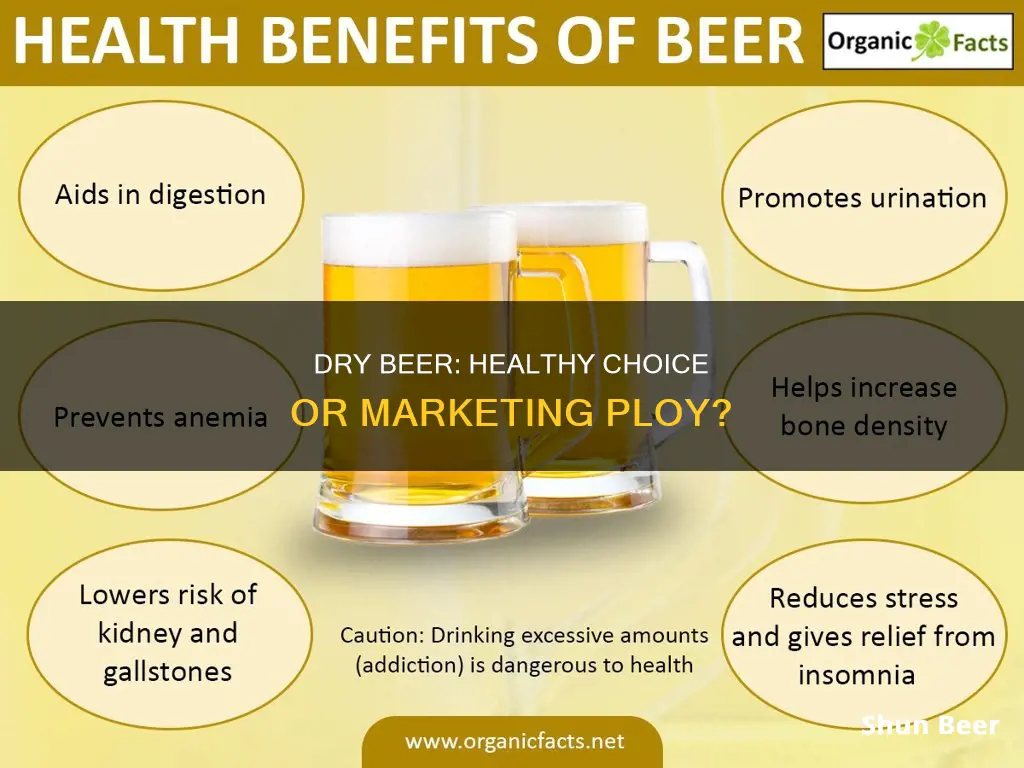
Dry beer is a type of beer with negligible or no residual sugar, resulting in a crisp finish, light body, and little to no sweetness. The term “dry” was first used to describe the lack of residual sweetness in traditional beers like stouts or porters. Dry beer usually has a clean and refreshing taste, with no aftertaste, despite its strong alcohol content. The fermentation process is extended to allow more natural sugars to break down and convert to alcohol, resulting in a beer with fewer carbs. While the first dry beer was Asahi Super Dry, which was invented in Japan, dry beers are now available worldwide, with unique variations in the US, Europe, and Australia.
| Characteristics | Values |
|---|---|
| Definition | Alcoholic beers with little to no residual sugars |
| Water Content | Unrelated to the dryness of beers |
| Taste | Crisp finish, light body, and little to no sweetness |
| Aftertaste | Absent |
| Fermentation | Extended to allow for more natural sugars to break down and convert to alcohol |
| History | First introduced in Japan in 1987 by Asahi Super Dry |
| Carbohydrates | Lower than regular beers |
| Calories | Lower than regular beers |
What You'll Learn

Dry beer has negligible or no sugar, but this doesn't mean it's not alcoholic
Dry beer is a type of beer with negligible or no sugar. The term "dry" was first used to describe the absence of the residual sweetness that characterises traditional beer types like stouts or porters. It has nothing to do with the water content. Dry beer generally has a crisp finish, light body, and little to no sweetness. It also has an absence of aftertaste, giving it a clean and refreshing taste despite its strong alcohol content.
The unique flavour profile of dry beer is the result of a special brewing technique. The mashing process, where malted barley and water are combined to create a sweet liquid called wort, is done at higher temperatures to break down more starches and decrease the amount of residual sugars. During the fermentation process, yeast breaks down sugars in the wort and produces alcohol and carbon dioxide. To create a dry beer, a specific strain of high-performing yeast is used to ferment more sugar, resulting in a beer with very little to no residual sugar.
The first dry beer on the market was the Japanese brand Asahi Super Dry, launched in March 1987. It quickly dominated the Japanese market and soon spread to the US, Europe, and Australia, with domestic brands introducing their dry brews from the 1990s to the early 2000s. Today, dry beer is available across the world, with popular brands like Budweiser and Corona also offering their own super dry beers.
While dry beer has negligible or no sugar, it is important to note that it is still an alcoholic beverage. The fermentation process in dry beer production is extended to allow for more natural sugars to break down and convert to alcohol. This results in a beer that is full in strength but has lower sugar content compared to traditional beers.
In summary, dry beer has negligible or no sugar due to the use of specific yeast strains and brewing techniques. However, this does not mean it is non-alcoholic. The fermentation process still produces alcohol, and dry beers can have varying alcohol levels depending on the brand and brewing methods.
Exploring the Fine Line: Beers and Health
You may want to see also

Dry beers are not necessarily high in ABV
The ABV, or alcohol by volume, of a beer depends on several factors, including the type of yeast, the amount of fermentable sugars, and the brewing process. While a higher amount of fermentable sugars can lead to a higher ABV, the type of yeast and the brewing process can also impact the final ABV.
Some dry beers, such as Asahi Super Dry, are known for their high alcohol content. The lack of residual sugars in dry beers can lead to a higher ABV, as more of the sugars are converted into alcohol during the fermentation process. This results in a crisp and refreshing drinking experience that is often preferred by beer lovers.
However, not all dry beers have a high ABV. For example, Bud Dry has an ABV of 5%, which is similar to many regular beers. Additionally, the brewing process and ingredients used can impact the final ABV, resulting in dry beers with varying levels of alcohol content.
It's important to note that the term "dry" is used differently by brewers in different parts of the world. While Japanese dry beers tend to have a higher alcohol content, American and European dry beers may have a wider range of ABV levels. The emphasis on a clean aftertaste and higher carbonation may also vary across regions.
In conclusion, while some dry beers have a high ABV, it is not a defining characteristic of all dry beers. The ABV of a dry beer can vary depending on the brewing process, ingredients, and regional interpretations of the "dry" style. As such, it's always a good idea to check the label for the alcohol content before consuming any type of beer.
Moscow Mule vs Beer: Which Cocktail is Healthier?
You may want to see also

Dry beers are not always dry-hopped
The term "dry" in dry beer refers to the lack of residual sweetness found in traditional beers like stouts or porters. Dry beers typically have a crisp finish, light body, and little to no sweetness. The fermentation process is extended to allow more natural sugars to break down and convert to alcohol, resulting in a beer with full strength and fewer carbs.
Dry-hopping, on the other hand, is a technique used to enhance the aroma and flavour of beer. It involves adding hops (either dried whole leaf or T-90 pellets) during or after primary fermentation. The hops contain compounds called alpha acids, which provide bitterness in beer when heated during the boil. However, dry-hopping preserves the delicate volatile oils that produce flavour and aroma, giving the beer a mouth-watering scent.
While some dry beers may be dry-hopped, it is not a requirement for a beer to be considered dry. The dryness in dry beer refers specifically to the lack of sweetness, which is achieved through extended fermentation, not through the addition of hops.
In summary, while dry-hopping is a popular technique used in brewing, particularly with IPAs, it is not the sole factor that determines whether a beer is classified as dry. The two terms describe different aspects of the brewing process and can be used independently or in combination to create a variety of beer styles.
Dos Equis Beer: Healthy Choice or Marketing Hype?
You may want to see also

Dry beers are generally low in calories and carbs
Dry beer is a type of beer with little to no residual sugar, resulting in a clean and crisp finish with little to no aftertaste. The term "dry" in the context of alcohol refers to the lack of sugar content, which is often used to describe fine wines with low sugar levels. Dry beers are created through a unique brewing process that involves mashing malted barley and water at higher temperatures to break down more starches and reduce residual sugars.
Dry beers are generally low in calories and carbohydrates, making them a popular choice among health-conscious consumers. The average regular beer contains approximately 115 calories or more, while a typical dry or super dry beer has only around 85 to 87 calories. This difference can be significant for those monitoring their calorie intake for health reasons. Additionally, dry beers have a lower carbohydrate content, with an average of 0.07 ounces (2 grams) per 12 ounces or a pint (355 milliliters) compared to 0.31 ounces (9 grams) of carbs per pint (335 milliliters) in regular beer.
The first officially produced dry beer was Asahi Super Dry, which originated in Japan in 1987. It quickly gained popularity and captured 40% of the Japanese beer market share. Soon after, other brands followed suit, and dry beer became a global trend. Today, many countries have their own versions of dry and super dry beers, including the United States, Canada, and Europe.
Super and extra dry beers differ from regular dry beers in that they are brewed and fermented to completely eliminate residual sugar content. As a result, they tend to have a more intense taste and are usually higher in bitterness. These beers often have an alcohol level above 5%, while dry beers can vary from below 5% to above 10% ABV.
Clarified Beer: Healthier Option or Just a Fad?
You may want to see also

Dry beers are not necessarily healthier than other beers
The term "dry" when applied to beer refers to the lack of sweetness in the drink, not to its water content or dryness level. Dry beers are characterised by a crisp finish, light body, and absence of aftertaste, resulting in a clean and refreshing taste. This unique flavour profile is achieved through a special brewing technique that involves mashing malted barley and water at higher temperatures to reduce residual sugars.
Super and extra dry beers are created through a similar process but differ from regular dry beers in that they have no residual sugar content and a more intense taste with higher bitterness levels. The alcohol level in super and extra dry beers is generally above 5%, while dry beers can have a wide range of alcohol content, from below 5% to above 10%.
While some brands promote their dry beers as low-carb and low-calorie options, it is important to note that this is not always the case. The average regular beer contains approximately 115 calories, while a dry or super dry beer typically contains 85-87 calories. In terms of carbohydrates, a regular beer has about 9 grams of carbs per pint, while a dry beer has around 2 grams per pint.
It is worth mentioning that the concept of "dry alcohol" originated from the French wine industry, where it was used to describe fine wines with little to no added sugar. This terminology was later adopted for other types of alcohol, including beer, in the late 1980s. Asahi Super Dry, produced in Japan, was the first certified dry beer.
In conclusion, while dry beers may have some health advantages due to their lower sugar content, they are not inherently healthier than other beers. The overall healthiness of a beer depends on various factors, and it is important to consider the specific nutritional values and ingredients when making a choice.
Beer Before Breakfast: Healthy Morning Drinking?
You may want to see also
Frequently asked questions
Dry beer is a type of beer with negligible or no residual sugar, resulting in a crisp finish, light body, and little to no sweetness. It has nothing to do with the water content or the dryness or wetness level of the beer.
Dry beers are generally considered healthier than other types of beers due to their lower sugar content, which also leads to reduced calorie and carb levels. However, it's important to note that drinking too much beer, even dry beer, can still lead to negative health effects.
Some popular dry beer brands include Asahi Super Dry, Sapporo Dry Beer, Sierra Nevada Brewing's Torpedo Extra IPA, and Anchor Brewing's Liberty Ale. These beers are known for their unique flavour profiles and have gained a dedicated following among beer enthusiasts.
Dry beer pairs well with bold food combinations such as spicy stir-fries, barbecue, and curried dishes. It also goes well with pizza, as the carbonation balances the acidity of tomatoes and the heaviness of cheese. Light lagers, a type of dry beer, complement the taste of sushi, shellfish, and fresh seafood.







